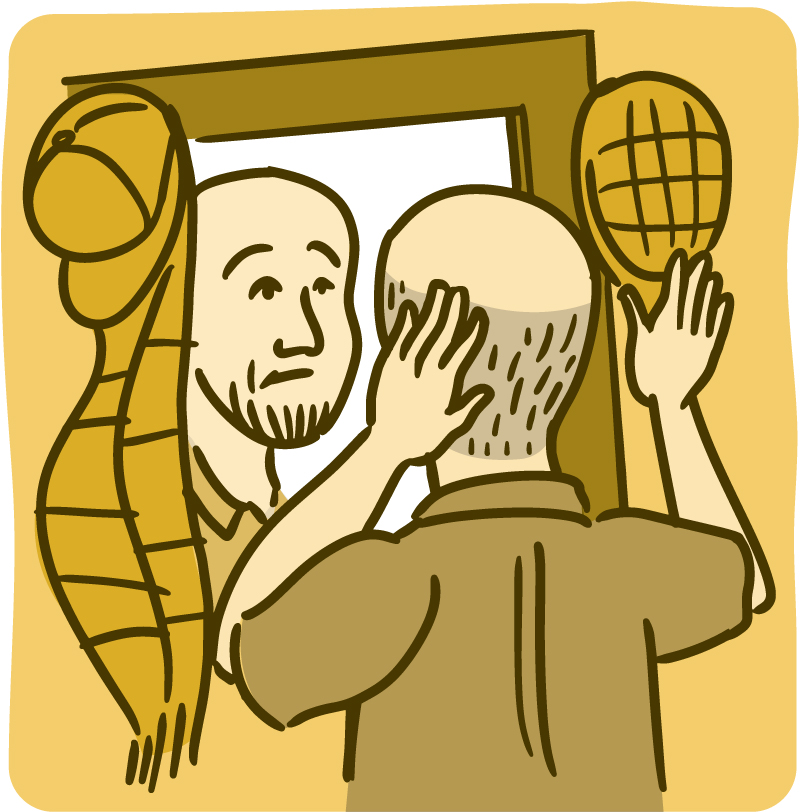Missing Strands?
Dealing with Hair Loss

Hair loss is often associated with men and aging, but it can happen to women and children, too. Many people have thinning hair or bald areas on their head.
You can lose hair slowly or quickly. Whether or not your hair will eventually grow back depends on the cause. A family history of baldness, medical conditions or their treatments, and many other things cause hair loss.
The most common type of hair loss is called androgenetic alopecia, also known as male- or female-pattern baldness. It tends to run in families and causes your hair to fall out gradually. As men get older, they may start to lose hair in the front of their scalp. The pattern of hair loss for women is different. Their hair may thin out all over their scalp, but is often most obvious along the part.
Both men and women with androgenetic alopecia can apply medicines to their scalp to slow the progression of their hair loss. However, some medications are only FDA-approved for men. Some men (and occasionally women) opt for hair transplant surgery, in which tiny plugs of hair are moved from the back of the head to the front. This option depends on how much hair is available for a transplant.
Another common type of hair loss is known as alopecia areata. Scientists recently discovered what causes this type of hair loss. Alopecia areata is an autoimmune disease. The immune system, which normally helps protect your body from disease, starts attacking hair follicles. Hair follicles are the part of the skin that hairs grow from. Usually, only small patches of hair on the scalp are lost. But in severe cases, hair all over the body may be lost. The hair loss may not be permanent because hair follicles are not destroyed. They are just stuck in a resting state.
Currently, there are no approved drugs for alopecia areata. However, an NIH-funded study recently discovered that a class of drugs called Janus kinase (JAK) inhibitors can stop, and even reverse, the disease. Dr. Angela Christiano, a skin disease expert at Columbia University, showed that JAK inhibitors block the damaging effects of the immune system on hair follicles. Many people who took the drug had their hair grow back in her study. More clinical trials are now underway to determine how safe and effective JAK inhibitors are for treatment of alopecia areata.
“I think it’s a hopeful time for patients with alopecia areata,” says Christiano, who also has the disease. She hopes that the excitement around alopecia areata research will carry over to other types of hair loss, which tend to be understudied diseases.
If you start losing clumps of hair or notice your hair thinning, check in with your doctor. They can help identify the cause, suggest possible treatments, and help you learn how to manage the condition.
Coping with the effects of hair loss on your head can be difficult, but there are many things you can do. “Find somebody that you trust and just talk about what’s going on,” advises Kathleen Baxley, who is the chief of social work at the NIH Clinical Center. She oversees a team that counsels people in clinical studies, including those who lose their hair because of a treatment. “It really helps folks a lot of the time just to tell their story. You can speak with a family member or close friend. Or, you can reach out to a counselor.”
“Sometimes finding support groups helps,” Baxley adds. Support groups meet in person or have discussions online. For other tips on how to manage hair loss, see the Wise Choices box.
NIH Office of Communications and Public Liaison
Health and Science Publications Branch
Building 31, Room 5B52
Bethesda, MD 20892-2094
Contact Us:
nihnewsinhealth@od.nih.gov
Phone: 301-451-8224
Share Our Materials: Reprint our articles and illustrations in your own publication. Our material is not copyrighted. Please acknowledge NIH News in Health as the source and send us a copy.
For more consumer health news and information, visit health.nih.gov.
For wellness toolkits, visit www.nih.gov/wellnesstoolkits.




